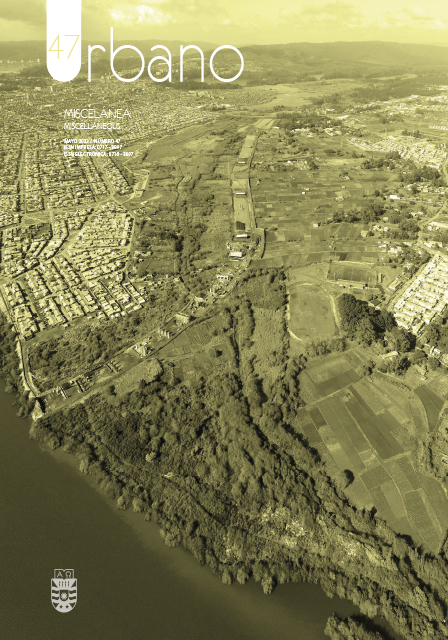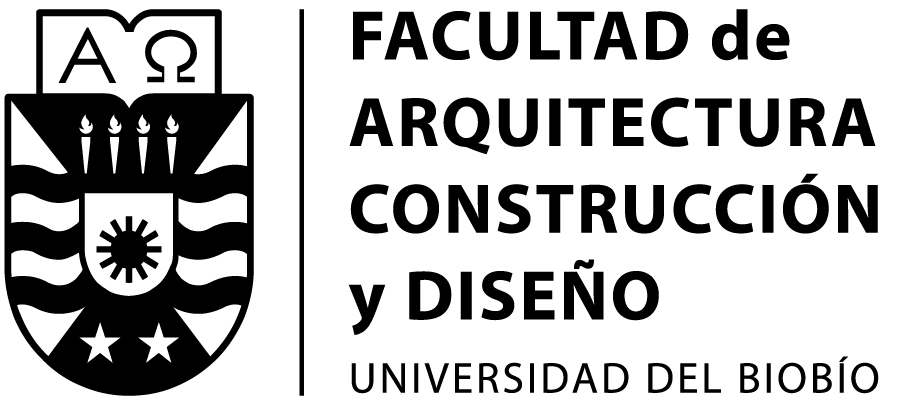Prácticas de movilidad cotidiana y estructura urbana en el entorno periurbano: Lomas Coloradas y Portal de San Pedro, San Pedro de la Paz (Chile)
DOI:
https://doi.org/10.22320/07183607.2023.26.47.03Palabras clave:
Movilidad cotidiana, periurbanización, sintaxis espacial, urbanizaciones cerradasResumen
Se propone comprender las prácticas de movilidad cotidiana en áreas residenciales periurbanas que son contiguas, pero presentan características distintas en cuanto a su origen histórico, diseño y trazado urbano, nivel socioeconómico y acceso a transporte público, en los sectores de Lomas Coloradas y Portal de San Pedro de la comuna de San Pedro de la Paz. A partir de un análisis cuantitativo, se analizó comparativamente el nivel de integración que permite la trama urbana usando el método Space Syntax (Hiller et al., 1987) mediante el software depthMapX, para luego identificar la cantidad de equipamientos y la densidad poblacional en base a datos disponibles del censo 2017. Por último, el desarrollo de la movilidad se estudió desde la aplicación de encuestas semiestructuradas enfocadas desde el punto de vista de la oferta. Los resultados muestran que el tipo de trama urbana y su nivel de integración local pierden incidencia en las prácticas de movilidad cotidiana cuando se trata de desplazamientos a nivel intercomunal. Así, dentro de la oferta de transporte, satisfacer únicamente la oportunidad de acceso no asegura la disminución de desigualdad urbana observada desde la movilidad cotidiana de los individuos.
Descargas
Citas
CASTRO, E., GONZÁLEZ, M. y MÚNEVAR, C. (2018). Paradigmas y tendencias en la organización del espacio rururbano: Una revisión teórica. Ciudad Y Territorio Estudios Territoriales, 50(196), 187-200. Recuperado de: https://recyt.fecyt.es/index.php/CyTET/article/view/85833
CERVERO, R. (2020). The transit metropolis: A 21st century perspective. En Deakin (Ed.) Transportation, Land Use, and Environmental Planning, 131-149. DOI: https://doi.org/10.1016/B978-0-12-815167-9.00007-4
FIGUEROA, C., GREENE, M. y MORA, R. (2018). Efectos de las autopistas urbanas en sus entornos inmediatos: un análisis desde la sintaxis espacial. Revista 180(42), 14-25. DOI: http://dx.doi.org/10.32995/rev180.Num-42.(2018).art-578
GALIMBERTI, C. (2018). Dispersión urbana en relación con los sistemas de movilidad: Caso región metropolitana de Rosario. Revista De Urbanismo, (38), 1-19. DOI: https://doi.org/10.5354/0717-5051.2018.48222
HERCE, M. (2009). Sobre la MOVILIDAD en la ciudad. Propuestas para recuperar un derecho ciudadano. Barcelona, España: Reverté.
HILLIER, B., PENN. A, HANSON, J., GRAJEWSKT, T. & XU, J. (1993). Natural Movement: Or, Configuration and Attraction in Urban Pedestrian Movement. Environment and Planning B: Planning and Design, 20(1), 29-66. Recuperado de: https://journals.sagepub.com/doi/abs/10.1068/b200029
HILLIER, B. (1996). Space is the machine: A configurational theory of architecture. Cambridge: Cambridge University Press
HILLIER, B., HANSON, J. & GRAHAM, H. (1987). Ideas are in things: an application of the space syntax method to discovering housing genotypes. Environment and Planning, Part B: Planning and Design, 14, 363-385.
INE. (2018). Densidad de población y vivienda por manzana. Recuperado de: http://inechile.maps.arcgis.com/apps/MapSeries/index.html?appid=1b135b078f024f6089b8d5d4728a369b
IDE, Observatorio de Ciudades UC (2017). Indicador Socio Material Territorial.
JACOBS, J. (1961). Muerte y vida de las grandes ciudades. España: Capitán Swing.
JIMÉNEZ, V., HIDALGO, R., CAMPESINO, A. y ALVARADO, V. (2018). Normalización del modelo neoliberal de expansión residencial más allá del límite urbano en Chile y España. Revista Eure, 44(132), 27-46. DOI: http://dx.doi.org/10.4067/s0250-71612018000200027
JIRÓN, P., LANGE, C. y BERTRAND, M. (2010). Exclusión y desigualdad espacial: retrato desde la movilidad cotidiana. Revista INVI, 25(68), 15-57. DOI: http://dx.doi.org/10.4067/S0718-83582010000100002
LYNCH, K. (1985). La imagen de la ciudad. Barcelona: Gustavo Gili
MARQUET, O. y MIRALLES, C. (2014). La proximidad en Barcelona. Un análisis desde los tiempos de desplazamiento cotidianos. Revista ciudades 17, 99-120. DOI: https://doi.org/10.24197/ciudades.17.2014.99-120
MAWROMATIS, C. (2013). Tensiones y convergencia: el diseño urbano contemporáneo como alternativa a la ciudad dispersa y difusa. Revista INVI, 28(79), 125-163. DOI: http://dx.doi.org/10.4067/S0718-83582013000300005
MORA, R. y GREENE, M. (2008). Dimensiones espaciales de la seguridad residencial: flujos de movimiento y campos visuales. Revista INVI, 28(74), 143-166. Recuperado de: https://revistainvi.uchile.cl/index.php/INVI/article/view/62292
NAPADENSKY, A. Y ORELLANA, A. (2019). Metropolización y organización funcional de sistemas urbanos intermedios. Gran La Serena, Concepción y Puerto Montt. Bitácora Urbano Territorial, 29(1), 65-78. DOI: http://dx.doi.org/10.15446/bitacora.v29n1.67325
NAPADENSKY, A. y VILLOUTA, D. (2019). Plataformas tecnológicas colaborativas: Entre la ciudad imaginada de la tradición y la reorganizada tras la innovación. Revista AUS, 26, 42-50. DOI: https://doi.org/10.4206/aus.2019.n26-08
PENN, A., HILLIER, B., BANISTER, D., & XU, J. (1998). Configurational Modelling of Urban Movement Networks. Environment and Planning B: Planning and Design, 25(1), 59-84. DOI: https://doi.org/10.1068/b250059
SALINAS, E. y PÉREZ, L. (2014) ¿Baja densidad o baja urbanidad? Tipologías de uso del suelo y ocupación. AM de Concepción. Revista Urbano, 29, 21-30. Recuperado de: http://revistas.ubiobio.cl/index.php/RU/article/view/233
STOCKINS, P (2004). Oferta y demanda de vivienda en la periferia santiaguina: los nuevos desarrollos inmobiliarios. En Cáceres y Sabatini. (Ed.), Barrios cerrados en Santiago de Chile. Entre la exclusión y la integración residencial, 83-111. Santiago, Chile: Pontificia Universidad Católica de Chile.
SUÁREZ, M. (2004) Interaprendizaje Holístico de Matemática. Ed. Gráficas, Planeta, Ibarra.
SVAMPA, M. (2001). Los que ganaron. La vida en los countries y barrios privados. Buenos Aires, Argentina: Biblos.
TIZNADO, I., MUÑOZ, J., IGLESIAS, V. y GIRALDEZ, F. (2019) Las inequidades de la movilidad urbana. Brechas entre los grupos socioeconómicos en Santiago de Chile. Documento n°1 para Políticas Públicas, Centro de Desarrollo Urbano Sustentable. Recuperado de: https://politicaspublicas.uc.cl/wp-content/uploads/2019/03/Las-inequidades-de-la-movilidad-urbana.pdf
ZUMELZU, A., BURGOS, R. y NAVARRO, S. (2016) Expansión periférica y procesos de centralidad en Valdivia entre 1900-2015: un análisis desde la perspectiva de la sintaxis del espacio. Revista AUS, 19, 24-30. DOI: https://doi.org/10.4206/aus.2016.n19-05
Descargas
Publicado
Cómo citar
Número
Sección
Licencia
Derechos de autor 2023 Yabel Arévalo-Molina, Leonel Pérez-Bustamante, Daniela Villouta-Gutiérrez

Esta obra está bajo una licencia internacional Creative Commons Atribución-CompartirIgual 4.0.
El contenido de los artículos y reseñas que se publican en cada número de Urbano, es responsabilidad exclusiva de los autores y no representan necesariamente el pensamiento ni comprometen la opinión de la Universidad del Bío-Bío.
Las/os autoras/es conservarán sus derechos de autor, sin embargo, garantizarán a la revista el derecho de primera publicación y difusión de su obra. La publicación del artículo en Urbano estará sujeta a la Licencia de Reconocimiento de Creative Commons CC BY-SA que permite a otros compartir-copiar, transformar o crear nuevo material a partir de esta obra para cualquier propósito, incluso comercialmente, siempre y cuando se reconozcan la autoría y la primera publicación en esta revista, y sus nuevas creaciones estén bajo una licencia con los mismos términos.![]()























